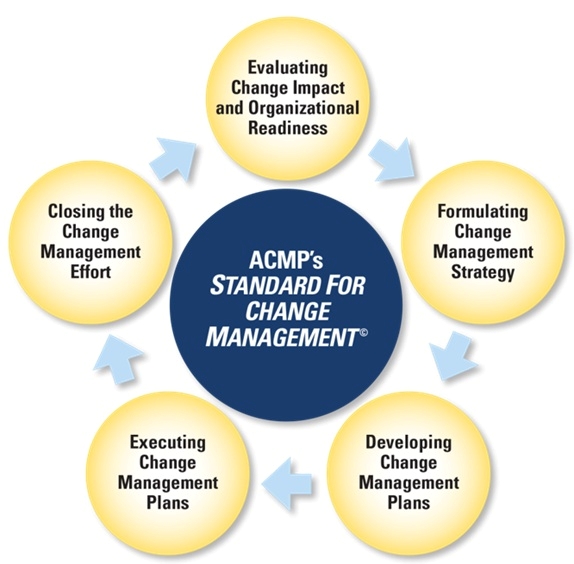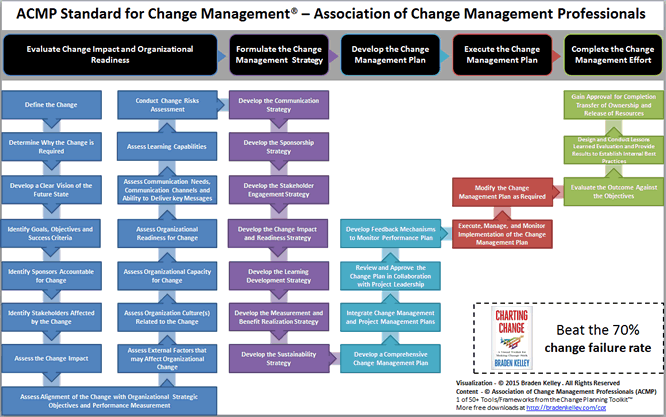 To supporters of my first book Stoking Your Innovation Bonfire and my latest book Charting Change, I am sad to say that the launch date for my new book, designed to make change less overwhelming and more human, has moved back to March 9, 2016.
To supporters of my first book Stoking Your Innovation Bonfire and my latest book Charting Change, I am sad to say that the launch date for my new book, designed to make change less overwhelming and more human, has moved back to March 9, 2016.
Get Everyone Literally on the Same Page for Change!
Charting Change – A Visual Toolkit for Making Change Stick, the follow-up to Stoking Your Innovation Bonfire, is being published by Palgrave Macmillan, and is now available for pre-order at all of the Amazon online bookstores (USA, UK, DE, FR, JP, CA) and many other retailers around the world. BookDepository.com ships FREE to nearly 90 countries.
What People Are Saying
 “There’s no denying it: Change is scary. But it’s also inevitable. In Charting Change, Braden Kelley gives you a toolkit and a blueprint for initiating and managing change in your organization, no matter what form it takes.”
“There’s no denying it: Change is scary. But it’s also inevitable. In Charting Change, Braden Kelley gives you a toolkit and a blueprint for initiating and managing change in your organization, no matter what form it takes.”
– Daniel H. Pink, author of Drive and To Sell is Human
 “Thoughtful, thorough, and practical is the rare blend that Braden has achieved in this Change Management field guide. Much more than a series of tactics, Charting Change will explicitly, sequentially, and visually help users create a diverse set of experiences for stakeholders that will most certainly increase likelihood of success.”
“Thoughtful, thorough, and practical is the rare blend that Braden has achieved in this Change Management field guide. Much more than a series of tactics, Charting Change will explicitly, sequentially, and visually help users create a diverse set of experiences for stakeholders that will most certainly increase likelihood of success.”
– Eric D. Hieger, Psy.D., Business Transformation and Change Leadership Practice Lead at ADP
 “As the pace of change speeds up, the market disruptions and resulting changes can be daunting for all. We all wish we could predict how change will affect our business, our market and our people. No matter what business area you come from, change affects us all and can produce great outcomes when managed well. In Braden Kelley’s newest book, Charting Change, he provides a terrific toolkit to manage this process and make it stick.”
“As the pace of change speeds up, the market disruptions and resulting changes can be daunting for all. We all wish we could predict how change will affect our business, our market and our people. No matter what business area you come from, change affects us all and can produce great outcomes when managed well. In Braden Kelley’s newest book, Charting Change, he provides a terrific toolkit to manage this process and make it stick.”
– Denise Fletcher, Chief Innovation Officer, Xerox
 “Braden Kelley and his merry band of guest experts have done a nice job of visualizing in Charting Change how to make future change efforts more collaborative. Kelley shows how to draw out the hidden assumptions and land mines early in the change planning process, and presents some great techniques for keeping people aligned as a change effort or project moves forward.”
“Braden Kelley and his merry band of guest experts have done a nice job of visualizing in Charting Change how to make future change efforts more collaborative. Kelley shows how to draw out the hidden assumptions and land mines early in the change planning process, and presents some great techniques for keeping people aligned as a change effort or project moves forward.”
– Phil McKinney, retired CTO for Hewlett-Packard and author of Beyond the Obvious
 “Higher employee retention? Increased revenue? Process enhancements? Whatever your change goal, Charting Change is full of bright ideas and invaluable visual guides to walk you through change in any area where your organization needs it.”
“Higher employee retention? Increased revenue? Process enhancements? Whatever your change goal, Charting Change is full of bright ideas and invaluable visual guides to walk you through change in any area where your organization needs it.”
– Marshall Goldsmith is the #1 New York Times bestselling author of Triggers, MOJO and What Got You Here Won’t Get You There
The Opportunity

Innovation is about change, and organizations and individuals resist change. But, if you look around the business ecosystem, you’ll see that the companies that successfully innovate in a repeatable fashion and stay at the top of their industries have one thing in common – they are good at managing change.
Research shows that up to seventy percent of all change initiatives fail. Let’s face it, change is hard, as is getting an organization on board and working through the process. One thing that has been known to be effective is onboarding teams not only to understand this change, but to see the process and the progress of institutional change. Charting Change will help teams and companies visualize this complicated process.
The Concept
I have developed the Change Planning Toolkit™ and the Change Planning Canvas™, which enable leadership and project teams to easily discuss the variables that will influence the change effort and organize them in a collaborative and visual way. It will help managers build a cohesive approach that can be more easily embraced by employees who are charged with the actual implementation of change. Charting Change will teach readers how to use this visual toolkit to build a common language and vision for implementing change.
The Supplemental Materials
 After the book launches, book buyers will get access to the Change Planning Toolkit™ Basic License which includes access to 26 of the 50+ frameworks, worksheets, and other tools (including the Change Planning Canvas™) in a 11″x17″ downloadable PDF format. To get access to poster size versions (35″x56″) of these tools, please contact me about upgrading to an affordable site license.
After the book launches, book buyers will get access to the Change Planning Toolkit™ Basic License which includes access to 26 of the 50+ frameworks, worksheets, and other tools (including the Change Planning Canvas™) in a 11″x17″ downloadable PDF format. To get access to poster size versions (35″x56″) of these tools, please contact me about upgrading to an affordable site license.
Click here to purchase the Change Planning Toolkit™ Basic License – Advance Purchase Edition now on this web site and get instant access to the supplemental materials and a digital version of the book when it becomes available.
The Toolkit
— Click here to get more information about the Change Planning Toolkit™
— Sign up for the latest news and alerts
Where to Buy (now available for pre-order until March 2016)
More Change Planning Toolkit™ Resources:
The Case Studies in Charting Change
 Challenge Top Down Change (@NHSEngland, @HSJnews and @NursingTimes)
Challenge Top Down Change (@NHSEngland, @HSJnews and @NursingTimes)
NHS Improving Quality, a national improvement body of NHS England, working in partnership with the Health Service Journal (HSJ) and the Nursing Times (NT) national healthcare management titles to challenge top down change.
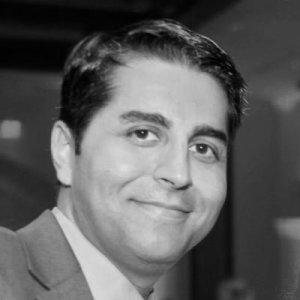 Qualcomm Flux – Babak Forutanpour
Qualcomm Flux – Babak Forutanpour
Babak Forutanpour (@bababinke) is a curious soul, an engineer, a UX Technologist, and a VFX Artist. He is the founder of Qualcomm’s FLUX and Co-Creator of Don’t Dream Alone. Creator of the @TheAryaBall.
The Guest Experts in Charting Change
 Beth Montag Schmaltz (@bethmschmaltz)
Beth Montag Schmaltz (@bethmschmaltz)
Beth Montag Schmaltz is a Founding Partner at 71 & Change, a strategy and implementation consulting company that designs and implements solutions to address today’s workforce challenges. Most importantly, we believe that Your People = Your Success.
 Dion Hinchcliffe (@dhinchcliffe)
Dion Hinchcliffe (@dhinchcliffe)
Dion Hinchcliffe is a Vice President and Principal Analyst at Constellation Research. He is a well-known business strategist, enterprise architect, book author, frequent keynote speaker, analyst, and transformation consultant.
 Matthew E. May (@matthewemay)
Matthew E. May (@matthewemay)
Matthew E. May is a strategy facilitator, innovation coach, and lean trainer. Author of four books (including The Laws of Subtraction and The Elegant Solution), working on a 5th.
 Ty Montague (@tmontague) and Rosemarie Ryan (@RosemarieRyan)
Ty Montague (@tmontague) and Rosemarie Ryan (@RosemarieRyan)
Co-Founders and Co-CEOs of co:collective, a strategy and innovation company that works with leadership teams to conceive and execute innovation in customer experience using a proprietary methodology called StoryDoing ©.
 Tanveer Naseer, MSc. (@TanveerNaseer)
Tanveer Naseer, MSc. (@TanveerNaseer)
Tanveer Naseer is an award-winning and internationally-acclaimed leadership writer, author of the book “Leadership Vertigo”, keynote speaker, and founder of Tanveer Naseer Leadership, a leadership coaching firm.
 Brett Clay (@sellingchange)
Brett Clay (@sellingchange)
Brett Clay is the Founder and President of Change Leadership Group, LLC and author, “Selling Change, 101 Secrets for Growing Sales by Leading Change.”
 Ayelet Baron (@ayeletb)
Ayelet Baron (@ayeletb)
Ayelet Baron is a futurist helping to build thriving 21st century organizations with conscious leaders who drive shared purpose. Ayelet is a keynote speaker and author whose purpose is to open people’s minds and hearts about what’s possible when we lifework in abundance.
 Seth Kahan (@sethkahan)
Seth Kahan (@sethkahan)
Seth Kahan is an executive advisor who guides CEOs on leading change and innovation to create powerfully positive impact.
.
 Rohit Talwar (@fastfuture)
Rohit Talwar (@fastfuture)
Rohit Talwar is a global futurist and CEO of Fast Future Research and Fast Future Publishing. He is the editor of The Future of Business – published in June 2015.
.
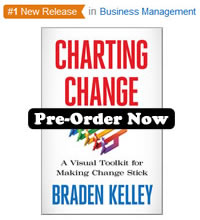 Table of Contents from Charting Change
Table of Contents from Charting Change
- Acknowledgements
- Preface
- Change Planning Canvas™ (2-page foldout)
- Chapter 1 – Changing Change
- Chapter 2 – Planning Change
- Chapter 3 – Understanding the Current State
- BONUS FEATURE – NHS (Case Study – Challenging Top Down Change)
- Chapter 4 – Exploring Readiness for Change and Transitions
- Chapter 5 – Envisioning the Desired State
- BONUS FEATURE – Seth Kahan (Guest Expert – Generating Dramatic Surges of Progress)
- Chapter 6 – Picking the Right Target for Your Change Effort
- Chapter 7 – The Benefits of Change
- Chapter 8 – The People Side of Change
- Chapter 9 – Barriers and Obstacles to Change
- BONUS FEATURE – Matthew E May (Guest Expert – Reverse Engineer Your Strategy)
- Chapter 10 – Not Everything about Change is Wonderful
- Chapter 11 – Breaking it Down
- Chapter 12 – Now What (The Resource Challenge)
- BONUS FEATURE – Beth Montag-Schmaltz (Guest Expert – Change Saturation)
- Chapter 13 – Building the Case for Change
- BONUS FEATURE – Brett Clay (Guest Expert – Selling Change)
- Chapter 14 – Communicating Change
- BONUS FEATURE – Ty Montague and Rosemarie Ryan (Guest Experts – StoryDoing)
- Chapter 15 – Leading Change
- BONUS FEATURE – Tanveer Naseer (Guest Expert – Leading Change)
- Chapter 16 – Innovation is All about Change
- BONUS FEATURE – Babak Forutanpour (Case Study – Qualcomm Flux)
- Chapter 17 – Project and Portfolio Management Are About Change
- BONUS FEATURE – Dion Hinchcliffe (Guest Expert – Digital Transformation Best Practices)
- Chapter 18 – The Future of Change
- BONUS FEATURE – Rohit Talwar (Guest Expert – The Future of Business)
- BONUS FEATURE – Ayelet Baron (Guest Expert – Change is Abundant in the 21st Century)
- About the Author

 Sign up here to get Human-Centered Change & Innovation Weekly delivered to your inbox every week.
Sign up here to get Human-Centered Change & Innovation Weekly delivered to your inbox every week.

![]() Sign up here to get Human-Centered Change & Innovation Weekly delivered to your inbox every week.
Sign up here to get Human-Centered Change & Innovation Weekly delivered to your inbox every week.
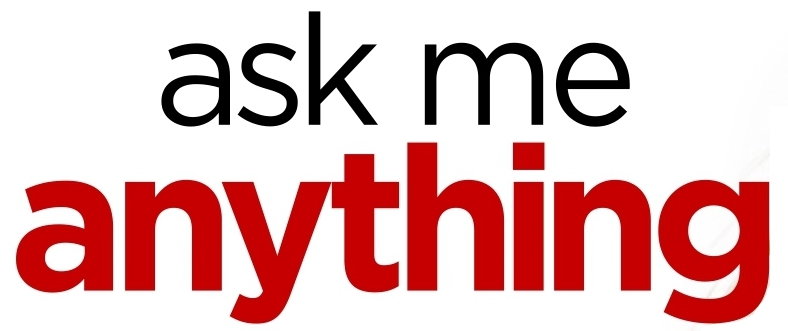
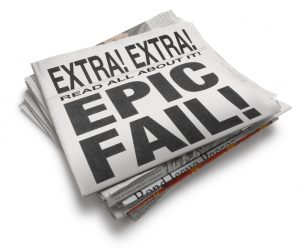 One scary statistic is that 70% of change initiatives fail. An overwhelming proportion of new product launches fail. Most new businesses fail.
One scary statistic is that 70% of change initiatives fail. An overwhelming proportion of new product launches fail. Most new businesses fail.
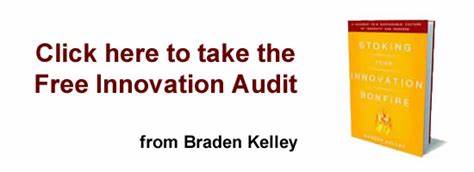
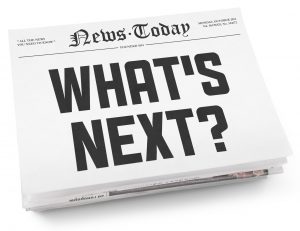
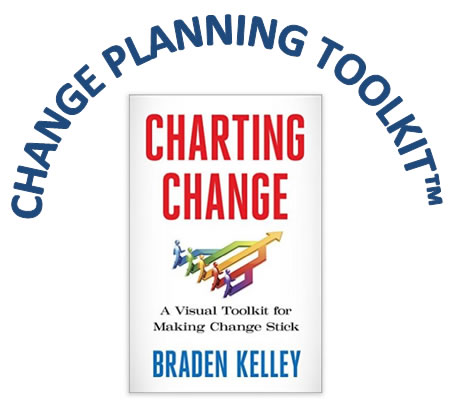



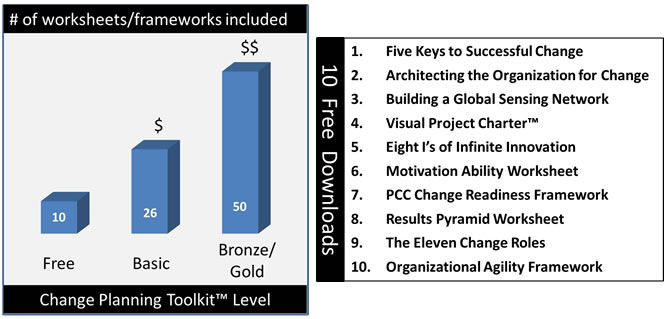
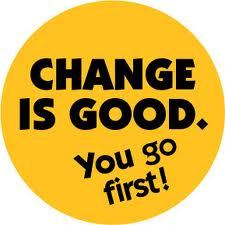 Change can be complicated, change can be confusing, and change can be difficult to successfully implement in any organization. This is why 70% of change initiatives have been found to fail.
Change can be complicated, change can be confusing, and change can be difficult to successfully implement in any organization. This is why 70% of change initiatives have been found to fail. 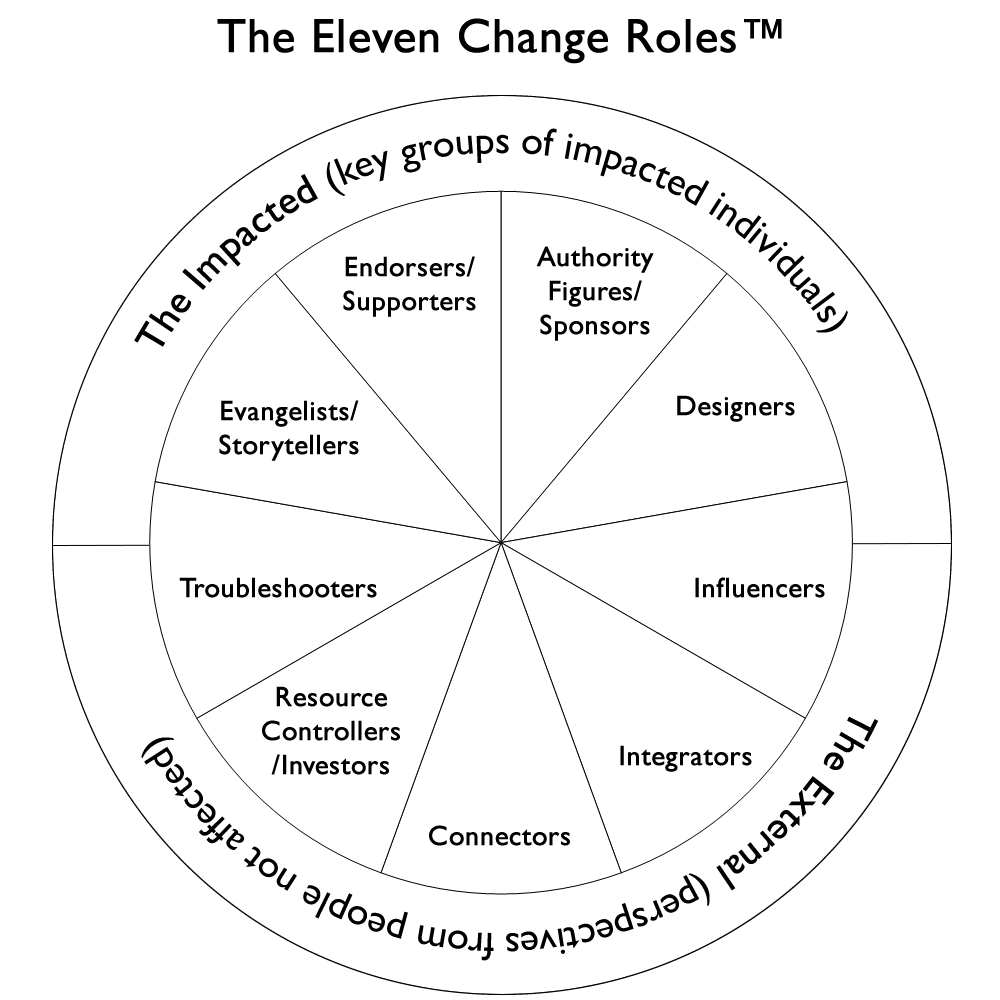

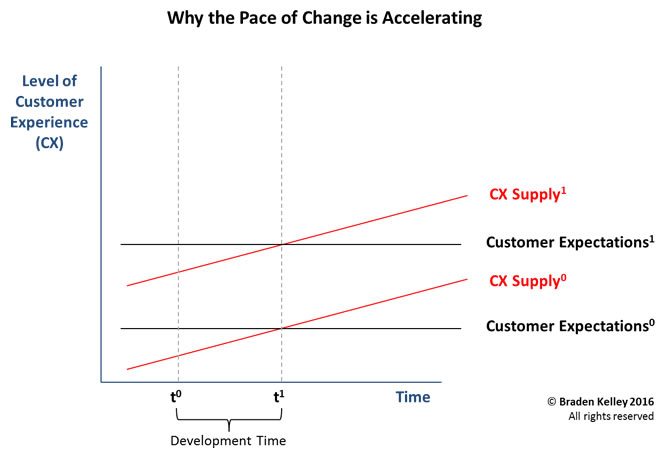

 Tanveer Naseer is an award-winning and internationally-acclaimed leadership writer and keynote speaker. He is also the Principal and Founder of Tanveer Naseer Leadership, a leadership coaching firm that works with executives and managers to help them develop practical leadership and team-building competencies to guide organizational growth and development.
Tanveer Naseer is an award-winning and internationally-acclaimed leadership writer and keynote speaker. He is also the Principal and Founder of Tanveer Naseer Leadership, a leadership coaching firm that works with executives and managers to help them develop practical leadership and team-building competencies to guide organizational growth and development. “There’s no denying it: Change is scary. But it’s also inevitable. In Charting Change, Braden Kelley gives you a toolkit and a blueprint for initiating and managing change in your organization, no matter what form it takes.”
“There’s no denying it: Change is scary. But it’s also inevitable. In Charting Change, Braden Kelley gives you a toolkit and a blueprint for initiating and managing change in your organization, no matter what form it takes.” “Thoughtful, thorough, and practical is the rare blend that Braden has achieved in this Change Management field guide. Much more than a series of tactics, Charting Change will explicitly, sequentially, and visually help users create a diverse set of experiences for stakeholders that will most certainly increase likelihood of success.”
“Thoughtful, thorough, and practical is the rare blend that Braden has achieved in this Change Management field guide. Much more than a series of tactics, Charting Change will explicitly, sequentially, and visually help users create a diverse set of experiences for stakeholders that will most certainly increase likelihood of success.” “As the pace of change speeds up, the market disruptions and resulting changes can be daunting for all. We all wish we could predict how change will affect our business, our market and our people. No matter what business area you come from, change affects us all and can produce great outcomes when managed well. In Braden Kelley’s newest book, Charting Change, he provides a terrific toolkit to manage this process and make it stick.”
“As the pace of change speeds up, the market disruptions and resulting changes can be daunting for all. We all wish we could predict how change will affect our business, our market and our people. No matter what business area you come from, change affects us all and can produce great outcomes when managed well. In Braden Kelley’s newest book, Charting Change, he provides a terrific toolkit to manage this process and make it stick.” “Braden Kelley and his merry band of guest experts have done a nice job of visualizing in Charting Change how to make future change efforts more collaborative. Kelley shows how to draw out the hidden assumptions and land mines early in the change planning process, and presents some great techniques for keeping people aligned as a change effort or project moves forward.”
“Braden Kelley and his merry band of guest experts have done a nice job of visualizing in Charting Change how to make future change efforts more collaborative. Kelley shows how to draw out the hidden assumptions and land mines early in the change planning process, and presents some great techniques for keeping people aligned as a change effort or project moves forward.” “Higher employee retention? Increased revenue? Process enhancements? Whatever your change goal, Charting Change is full of bright ideas and invaluable visual guides to walk you through change in any area where your organization needs it.”
“Higher employee retention? Increased revenue? Process enhancements? Whatever your change goal, Charting Change is full of bright ideas and invaluable visual guides to walk you through change in any area where your organization needs it.”

 Challenge Top Down Change (@NHSEngland, @HSJnews and @NursingTimes)
Challenge Top Down Change (@NHSEngland, @HSJnews and @NursingTimes) Qualcomm Flux – Babak Forutanpour
Qualcomm Flux – Babak Forutanpour Beth Montag Schmaltz (@bethmschmaltz)
Beth Montag Schmaltz (@bethmschmaltz) Dion Hinchcliffe (@dhinchcliffe)
Dion Hinchcliffe (@dhinchcliffe) Matthew E. May (@matthewemay)
Matthew E. May (@matthewemay) Ty Montague (@tmontague) and Rosemarie Ryan (@RosemarieRyan)
Ty Montague (@tmontague) and Rosemarie Ryan (@RosemarieRyan) Tanveer Naseer, MSc. (@TanveerNaseer)
Tanveer Naseer, MSc. (@TanveerNaseer) Brett Clay (@sellingchange)
Brett Clay (@sellingchange) Ayelet Baron (@ayeletb)
Ayelet Baron (@ayeletb) Seth Kahan (@sethkahan)
Seth Kahan (@sethkahan) Rohit Talwar (@fastfuture)
Rohit Talwar (@fastfuture)

